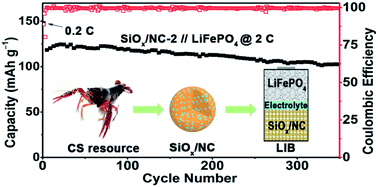Micron-sized SiOx/N-doped carbon composite spheres fabricated with biomass chitosan for high-performance lithium-ion battery anodes†
Abstract
To achieve superior lithium storage performance, SiOx is usually designed into nanostructured SiOx/C composites by complex or expensive methods. Here, micron-sized interconnected SiOx/N-doped carbon (NC) microspheres composed of evenly dispersed SiOx nano-domains and NC have been fabricated by a scalable microemulsion method and following pyrolysis, using vinyltriethoxysilane and chitosan as precursors. The unique structure of the micron-sized SiOx/NC spheres leads to enhanced structural integrity and enables stable long-term cycling (800 cycles at 2 A g−1). Benefiting from the enhanced electron/Li+ diffusion kinetics originated from the unique structure and N-doping, SiOx/NC-2 presents considerable capacitive-controlled Li storage capacity, which leads to outstanding rate capability. Consequently, the assembled SiOx/NC-2//LiFePO4 full cell exhibits superior rate capability (106 mA h g−1 at 4C) and stable long-term cycling at 2C (102 mA h g−1 after 350 cycles). This work opens a new door for the application of chitosan in building micron-sized high-performance SiOx/C anode materials, and to some extent facilitates the recycling of waste seafood shells.



 Please wait while we load your content...
Please wait while we load your content...